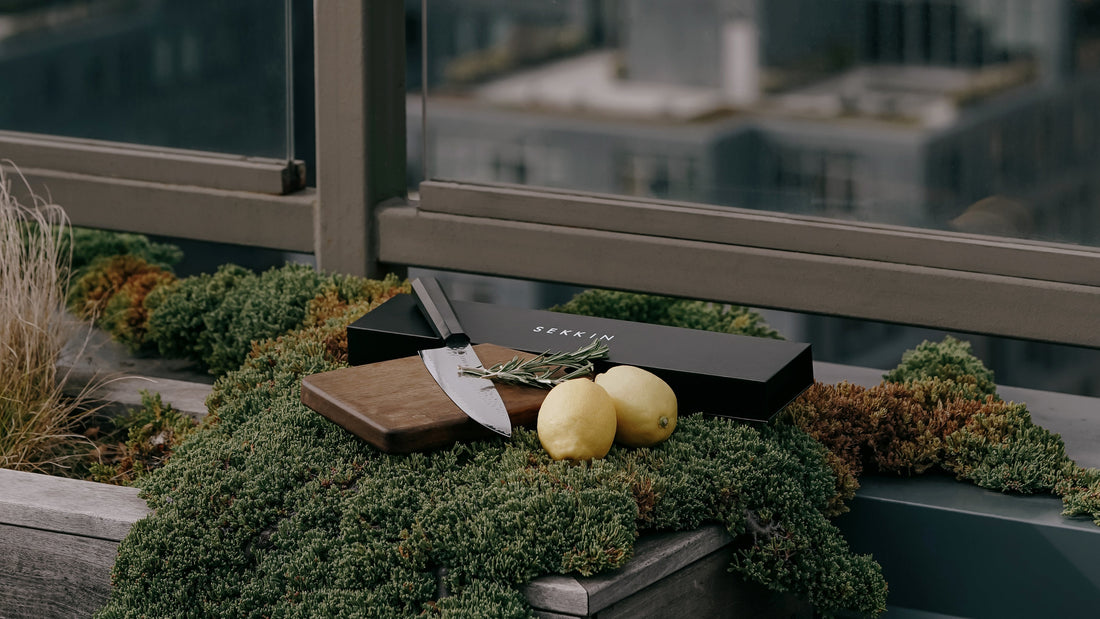
The Ultimate Guide to Chef's Knives: Everything You Need to Know
Share
As a kitchenware enthusiast, you know that a chef's knife is one of the most essential tools in the kitchen. Whether you're a professional chef or a home cook, understanding the ins and outs of chef's knives can really enhance your cooking. In this comprehensive guide, we'll cover everything you need to know about chef's knives.
What is a Chef's Knife Used For?
A chef’s knife is the ultimate all-purpose tool for any kitchen. Perfect for chopping, slicing, dicing, and mincing everything from vegetables to meats, its broad, sharp blade ensures precision and efficiency. If you could only have one knife in your kitchen, this would be the one.
What Size Chef's Knife Should I Choose?
Chef’s knives typically range from 6 to 12 inches in blade length, with an 8-inch knife—like the SEKKIN Chef’s Knife—being the most popular for its balance of control and efficiency. The best choice is the size that feels comfortable in your hand and suits your cutting needs.
What Materials Are Chef's Knives Made From?
Stainless Steel:
Durable and resistant to rust and stains, stainless steel is ideal for everyday use.
Carbon Steel:
Known for its sharpness and edge retention, carbon steel requires more maintenance to prevent rust.
Ceramic:
Extremely hard and sharp, ceramic knives stay sharp longer but can chip easily and are harder to sharpen.
Damascus Steel:
Combines durability and sharpness with distinctive patterns, often considered a premium option. For these reasons, it's our go-to steel for the SEKKIN Chef's Knife.
How Should I Properly Care for and Maintain My Chef's Knife?
Sharpening:
Regularly sharpen your knife using a whetstone, honing rod or professional sharpening service to maintain its edge and keep it sharp.
Cleaning:
Hand wash your knife with mild detergent and dry it immediately to prevent rust and maintain its quality.
Storage:
Store your knife in a knife block, magnetic strip, or in-drawer knife tray to protect the blade and prevent accidents.
Oiling:
Periodically oil the blade and handle with food-grade mineral oil to prevent rust and maintain the wood's integrity and appearance.
How Often Should I Sharpen My Chef's Knife?
The frequency of sharpening depends on how often you use your knife. For regular home use, sharpening every 2-3 months is ideal, though some SEKKIN Chef’s Knife owners have gone up to 6 months without needing it. Professional chefs, on the other hand, may sharpen their knives as often as daily. Regular honing helps maintain the edge between sharpenings, extending the time between full resharpening sessions.
What's the Difference Between a Western and Japanese Chef's Knife?
Western Chef's Knife:
Heavier, with a curved blade designed for a rocking motion. It has a double-beveled edge and is versatile for various tasks.
Japanese Chef's Knife (Gyuto):
Lighter and thinner, with a straighter edge designed for precision cutting. It can have single or double-beveled edges, ideal for detailed and delicate work. The SEKKIN Chef's Knife is a Japanese-style chef's knife.
How Do I Choose the Right Chef's Knife for My Needs?
Purpose:
Make sure that the knife can handle the primary tasks you need, such as chopping, slicing or dicing.
Comfort:
Select a knife that feels balanced and comfortable in your hand. Some people prefer lightweight knives, while others prefer heavier ones.
Quality:
Look for brands using high-quality materials within your budget.
How Do I Safely Handle and Use a Chef's Knife?
Grip:
Use a firm, comfortable grip on the handle to maintain control.
Cutting Technique:
Use a rocking motion with the chef's knife, keeping your fingers tucked in to avoid cuts.
Stability:
Make sure that your cutting board is stable by placing a damp cloth underneath to prevent slipping.
What Are Signs That My Chef's Knife Needs Sharpening?
Dullness:
If you find it difficult to cut through foods, the knife is likely dull and needs sharpening.
Edge Inspection:
Visually inspect the blade edge for nicks and dull spots.
Performance Test:
Try cutting a tomato or a piece of paper. If the knife struggles, it needs sharpening.
How Do I Test the Sharpness of My Chef's Knife?
Paper Test:
Slice through a piece of paper. A sharp knife will cut cleanly without tearing.
Tomato Test:
A sharp knife will easily slice through a tomato's skin without pressing down.
A chef's knife is the most important tool of any kitchen, and taking the time to choose the right one and maintain it properly will pay off in your cooking adventures. At SEKKIN, we pride ourselves on providing top-quality chef's knives that meet your culinary needs. Explore our collection and elevate your kitchen game today!
